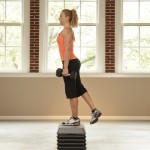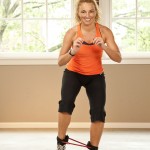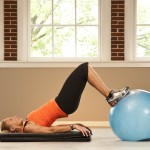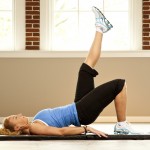Here’s some tips to conditioning your hips in a variety of ways:
Perform these exercises 2 days per week
 Leg Step Up:
Leg Step Up:
Holding a set of hand weights, position yourself in front of a bench with one foot on the bench. The bench should be at a height that puts your knee at a 90 degree angle. Keep your kneecap facing forward and your weight distributed on all four corners of your foot. Now slowly step up extending the supporting knee into a fully upright, balanced position. Now slowly lower yourself down to the starting position. Perform 1-2 sets of 8-12 reps to fatigue for each leg. Keep the height shorter if this bothers your knees at all.
Resisted Lateral Steps:
Wrap an exercise tube (exercise cuffs) around your ankles. Standing tall with abdominals tight, slowly step side to side maintaining resistance on the tube. Continue for 1-2 minutes.
 Stability Ball Hamstring Curls:
Stability Ball Hamstring Curls:
Lay on your back with your feet positioned on an exercise ball. With your arms at your side, slowly lift your hips and buttocks up towards the ceiling while contracting your glutes (buttocks) and hamstrings (back of thigh) until your body weight is resting comfortably on your shoulder blades. Throughout the entire exercise, be sure to keep your hips square to the ceiling and your abdominals contracted. Now slowly curl the ball in towards your body while maintaining control and stability through your core area. Slowly curl out and in 8-20x for one to two sets. Feel free to take breaks as needed.
 Leg Bridging:
Leg Bridging:
Lay on your back with 1 leg bent, foot on the floor and the other leg lifted straight up to the ceiling. With your arms at your side, slowly lift your hips and buttocks up towards the ceiling while contracting your glutes (buttocks) and hamstrings (back of thigh) until your body weight is resting comfortably on your shoulder blades. Throughout the entire exercise, be sure to keep your hips square to the ceiling and your abdominals contracted. Be sure not to tilt to one side while doing these 1-leg lifts. Slowly lift up and down 8-20x for 1-2 sets.
Side Lying Outer Thigh Leg Lifts:
Lie on your side with your body straight. Keep you abdominals contracted as you lift the top leg upwards. Hold at the upper end range of motion and then return to the starting position. Complete 1-2 sets of 8-20 reps each leg. If this is too easy, perform this exercise with tubing wrapped around your ankles to increase the resistance.





















